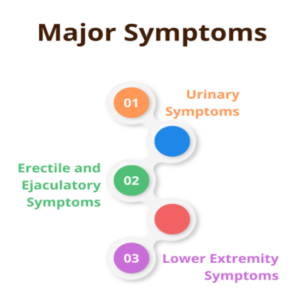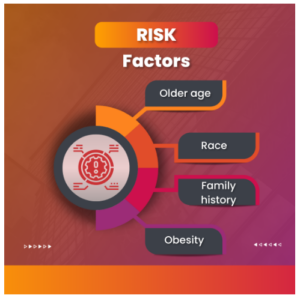Prostate cancer is a common type of cancer in males, but it is highly treatable in the early stages. The symptoms of prostate cancer are not very prominent all the time. About 85 percent of prostate cancers are detected during early screening tests before the patient develops any symptoms. Prostate cancer is the most common cancer affecting males in the United States. The American Cancer Society (ACS) predicts that in 2021 there will be around 248,530 new diagnoses of prostate cancer and approximately 34,130 deaths from this type of cancer. Prostate cancer may cause no signs or symptoms in its early stages.
In this comprehensive blog, we delve into the intricacies of prostate cancer symptoms, shedding light on this often overlooked yet formidable adversary.
Causes
Researchers are unsure of the exact cause of prostate cancer. It develops when specific changes occur, usually in glandular cells. When prostate gland cells appear abnormal, a doctor may refer to these changes as prostatic intraepithelial neoplasia (PIN). Nearly 50%Trusted Source of all males over the age of 50 years have PIN.
At first, the changes will be slow, and the cells will not be cancerous. However, they can become cancerous with time. Cancer cells can be high or low grade. High-grade cells are more likely to grow and spread, while low-grade cells are not likely to grow and are not a cause for concern.
Know About Prostate
The prostate, a small gland nestled below the bladder and in front of the rectum, plays a pivotal role in male reproductive health. Responsible for producing seminal fluid, the prostate’s normal function can be disrupted when abnormal cells begin to proliferate, leading to the formation of a tumor – the hallmark of prostate cancer. The signs of prostate cancer are quite intense sometimes. It’s always better to look into the prostate symptoms earlier for quick prevention.
Staging typically describes how much cancer is present in the body and how serious the cancer is. Knowing the stage of prostate cancer can help a person understand what to expect and will inform decisions about treatment.
Cancer staging is complex and accounts for many different factors. Usually, the lower the number, the less the cancer has spread. Stages may include:
- Stage I: Cancer is only present in the prostate gland.
- Stage II: Cancer has not yet spread from the prostate, but a person will have a higher PSA level.
- Stage III: Cancer may have spread to nearby tissues.
- Stage IV: Cancer may have spread to distant parts of the body.
Symptoms of Prostate Cancer
Though early warning signs of prostate cancer are rare, sometimes men experience symptoms before they are diagnosed. The severity of symptoms may depend on where the cancer is located in the prostate and how advanced it has become.
However, having any of these symptoms does not necessarily mean that you have prostate cancer or that the disease has progressed beyond its early stages.

Urinary Symptoms
- A need to urinate frequently, especially at night
- Difficulty starting urination or holding back urine
- A weak or interrupted flow of urine
- Painful or burning urination
- Hematuria (blood in the urine)
Erectile and Ejaculatory Symptoms
- Difficulty achieving or maintaining an erection
- Painful ejaculation
- Blood in the semen
- Decreased volume of ejaculation (though hydration, diet, and frequency of ejaculation are more likely than prostate cancer to impact the volume of fluid)
Lower Extremity Symptoms
- Frequent pain or stiffness in the lower back, hips, or upper thighs
- Swelling in the lower extremities
Common Symptoms:
Urinary Changes:
- Frequent urination, particularly at night, may signal prostate cancer.
- Difficulty initiating or stopping urination.
- A weakened or interrupted urinary stream.
- An urgent need to urinate.
- Blood in Urine or Semen:
- The presence of blood in the urine or semen.
- A pinkish tint in the urine, which could indicate vascular changes associated with prostate cancer.
Erectile Dysfunction:
- Prostate cancer may influence erectile function, leading to difficulties in achieving or sustaining an erection.
- Pain and Discomfort:
- Discomfort or pain during ejaculation.
- Pain or stiffness in the lower back, hips, or thighs, suggesting potential metastasis.
Weight Loss and Fatigue:
- Unexplained weight loss, is often accompanied by persistent fatigue and weakness.
- Advanced Symptoms:
- Advanced stages may bring about bone pain, particularly in the spine, hips, or pelvis, as the cancer spreads to nearby bones.
- Swelling in the legs or pelvic area, is indicative of more widespread metastasis.
Risk Factors
Factors that can increase your risk of prostate cancer include:

-
Older age
Your risk of prostate cancer increases as you age. It’s most common after age 50.
-
Race
For reasons not yet determined, Black people have a greater risk of prostate cancer than people of other races. In Black people, prostate cancer is also more likely to be aggressive or advanced.
-
Family history
If a blood relative, such as a parent, sibling, or child, has been diagnosed with prostate cancer, your risk may be increased. Also, if you have a family history of genes that increase the risk of breast cancer (BRCA1 or BRCA2) or a very strong family history of breast cancer, your risk of prostate cancer may be higher.
-
Obesity
People who are obese may have a higher risk of prostate cancer compared with people considered to have a healthy weight, though studies have had mixed results. In obese people, the cancer is more likely to be more aggressive and more likely to return after initial treatment.
The Importance of Early Detection
Advantages of Early Detection:
Early detection of prostate cancer significantly improves treatment outcomes and survival rates. Regular screenings, including PSA testing and DREs, enable healthcare professionals to identify prostate cancer in its early stages when it is more likely to be localized and responsive to treatment.
Treatment Options:
Understanding the available treatment options for prostate cancer is pivotal for informed decision-making. Treatment modalities may include surgery, radiation therapy, hormone therapy, chemotherapy, and immunotherapy. The choice of treatment depends on factors such as the stage of cancer, overall health, and individual preferences.
Learn more about Prostate Cancer Treatment Cost In India
Tips to Improve Prostate Symptoms
-
Indulge fruits and vegetables
Eat a variety of fruits, vegetables and whole grains. Fruits and vegetables contain many vitamins and nutrients that can contribute to your health.
-
Choose healthy foods over supplements
No studies have shown that supplements play a role in reducing your risk of prostate cancer. Instead, choose foods that are rich in vitamins and minerals so that you can maintain healthy levels of vitamins in your body.
-
Exercise
Exercise improves your overall health, helps you maintain your weight and improves your mood. Try to exercise most days of the week. Anybody who is new to exercise, start slow and work your way up to more exercise time each day.
-
Maintain a healthy weight
Choosing a nutritious diet and doing regular exercise will help you maintain your present weight if it is healthy. If you need to lose weight, add more exercise and reduce the number of calories you eat each day. Ask your doctor for help creating a plan for healthy weight loss.
-
Follow Medication and Treatment Plans
Adhering to prescribed medications and treatment plans is crucial for effectively managing prostate cancer symptoms. Communicate openly with your healthcare team about any concerns or side effects you may be experiencing.
-
Seek Support
Prostate cancer can take an emotional toll, and seeking support from friends, family, or support groups can provide valuable assistance. Talking openly about your feelings and concerns with others who have experienced similar situations can be both comforting and informative.
-
Regular Check-ups
Regular follow-up appointments and screenings are essential for monitoring prostate cancer and addressing any new symptoms or concerns promptly. Stay proactive in your healthcare and communicate openly with your medical team.
-
Manage Stress
Chronic stress can exacerbate prostate cancer symptoms and negatively impact mental well-being. Practice stress-reducing techniques such as meditation, deep breathing exercises, yoga, or mindfulness to promote relaxation and emotional balance.
Key Takeaway
In conclusion, recognizing and addressing symptoms of prostate cancer is paramount for early detection and effective management. It is crucial for men, especially those at higher risk, to be vigilant about their prostate health and promptly consult with healthcare professionals if any potential symptoms arise. Early intervention not only improves the chances of successful treatment but also helps mitigate the impact of the disease on overall well-being.
While managing prostate cancer symptoms may present challenges, incorporating these tips into your daily life can contribute to a healthier and more comfortable journey. Remember to consult with your healthcare team regularly and tailor these suggestions to your individual needs and circumstances. By adopting a holistic approach, individuals can actively participate in their well-being and enhance their overall quality of life.
Frequently Asked Questions:
What are the 5 early warning signs of prostate cancer?
When symptoms do occur, they can include: trouble urinating or decreased force of stream, blood in the urine or semen, bone pain, unexpected weight loss, and unexplained fevers. If you consistently notice any of these symptoms, you should see your doctor right away
Can prostate cancer be cured?
Prostate cancer can be cured when detected and treated early. The vast majority of prostate cancer cases (more than 90 percent) are discovered in the early stages, making the tumors more likely to respond to treatment. Treatment doesn’t always have to mean surgery or chemotherapy, either.
What is the main cause of prostate cancer?
Several things can increase your risk of developing the condition. These include: age – the risk rises as you get older, and most cases are diagnosed in men over 50 years of age. ethnic group – prostate cancer is more common in black men than in Asian men.
What are the first signs of a prostate problem?
The initial signs include a frequent urge to urinate, need to get up many times during the night to urinate, blood in urine or semen, pain or burning urination, and painful ejaculation.

